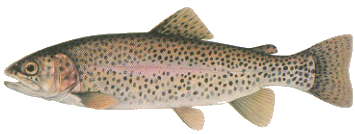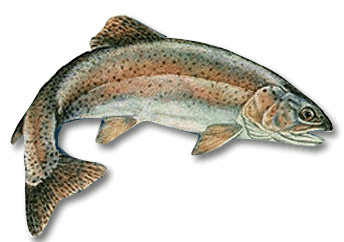Rainbow Trout |
|
Originally a native of the Pacific coast drainage system from Mexico to Alaska, it is now found in every Canadian province as a result of stocking. Sea-run rainbows on the Pacific coast are known as steelhead.
The rainbow has an elongated body, with an iridescent, reddish band running along each side from head to
tail. Both the colour and size of this fish vary with the environment. In general, large rainbows are caught in large bodies of water and small ones in streams and ponds. Stream-caught fish usually weigh under 1 lb, while fish from the rivers and lakes weigh between 1.5 and 6 lb.
Most rainbow spawn in spring. The female digs and spawns in several nests depositing 800-1000 eggs in each redd. These eggs usually hatch 4-7 weeks later. The life expectancy can be as low as 3-4 years. Rainbow often spawn in smaller tributarry streams, but Slocan River mainstem fish are generally beleived to spawn in the River itself.
The rainbow trout is well adapted to both streams and lakes. While it prefers cold, clear, swift-flowing water.
Rainbow trout can swim at over 20 mph (or 37 kilometers per hour). A rainbow can easily leap into the air three or four times its body length. The sensory input received by a rainbow is estimated to be 500 to 800 times more acute than the sensory input received by a human. This fish can perceive its surrounds to a degree that we can only imagine. The fish's brain is entirely devoted to bodilyfunctions and sensory input.
 A trout is somewhat near sighted but can see quite well to distances of about twenty feet. Rainbow see in color. They see color in the red to blue wavelengths about the same as a human, but much better than we do in the yellow to green wavelengths. Yellow to blue wavelengths travel better in water than in air.
A trout is somewhat near sighted but can see quite well to distances of about twenty feet. Rainbow see in color. They see color in the red to blue wavelengths about the same as a human, but much better than we do in the yellow to green wavelengths. Yellow to blue wavelengths travel better in water than in air.
Having the eyes on the side of the head also gives the rainbow trout a different perspective on the world. The fish can see to the front, sides and most of the way behind. The only blind spots are immediately behind and directly below the fish. Upward and directly in front, the fish has depth perception or binocular vision as both eyes come into play.
The rainbow doesn't have an external ear yet it can hear sound better than almost all land animals using a three-chambered 'internal' ear. If you drop your glasses in the bottom of the boat, a trout across a large lake will easily hear that sound.
The senses of taste and smell are particularly well developed in the rainbow trout. It is believed that migratory salmonids use taste and smell to help locate the waters of their original spawning streams. A rainbow trout can smell the difference between two aquatic plants of the same species that are side by side. Rainbow trout are very sensitive to differences in ph, salinity and the differences in amino acids as found in their food sources. It is thought that the Rainbow may have taste and smell sensors on parts of its body other than in the nostrils and mouth and that these may help the trout in locating its food.
Besides the normal touch sense that most animals have, the rainbow trout has what scientists are calling the "Distant Touch" sense. Water is 800 times denser than air. In part, this is why the trout can hear, smell, taste and see color so well. As a denser medium, water carries the mechanisms for sensory input much better than air. The senses of touch and perception are no different. The Rainbow can feel and perceive distant objects or movements about 800 time's better than we can and may even have a form of echolocation.
Imagine that someone drops a ball of cheese at the other end of a football field. Other than the fact that you saw it drop, you probably wouldn't know that it had happened. At that distance, with its eyesight, a Rainbow trout wouldn't see the cheese ball drop. However, underwater it could 'feel' the concussion of the cheese ball hitting the ground, hear the sound it makes when it hits and may even be able to smell and taste the cheese shortly after the hard outer cover breaks. It is even possible that, through echolocation, the trout could tell us exactly where the cheese ball hits in the end zone.
The trout's primary receptor for this ability is the Lateral Line. It is also known that the Supra-Orbital and Sub-Orbital lines on the jaw and back on the trout's skull play a similar role. The trout may have other distant touch receptors of which we are yet unaware. The full sensory capabilities of the Rainbow are yet to be determined by the scientific community.
Content on Fish Senses form: Fish BC